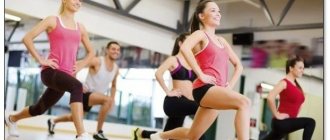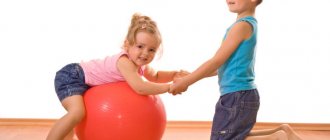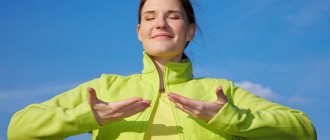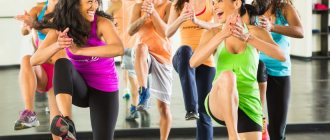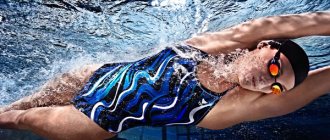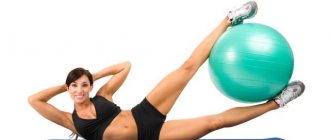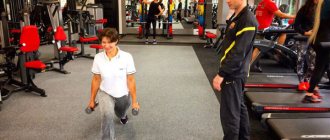According to the degree of influence on the body, all types of health-improving physical culture (depending on the structure of movements) can be divided into two large groups: exercises of a cyclic and acyclic nature.
Cyclic exercises are motor acts in which the same complete motor cycle is constantly repeated for a long time. These include walking, running, skiing, cycling, swimming, rowing.
Acyclic exercises are those in which the structure of movements does not have a stereotypical cycle and changes during their execution. These include gymnastic and strength exercises, jumping, throwing, sports games, and martial arts.
Acyclic exercises have a predominant effect on the functions of the musculoskeletal system, resulting in increased muscle strength, reaction speed, flexibility and mobility in the joints, and lability of the neuromuscular system.
Types with a predominant use of acyclic exercises include hygienic and industrial gymnastics, classes in health and general physical training (GPP) groups, rhythmic and athletic gymnastics, and gymnastics using the “hatha yoga” system.
Morning hygienic exercises
Morning hygienic exercises help to quickly bring the body into working condition after waking up, maintain a high level of performance during the working day, improve coordination of the neuromuscular system, and the activity of the cardiovascular and respiratory systems.
During morning exercises and subsequent water procedures, the activity of skin and muscle receptors, the vestibular apparatus is activated, the excitability of the central nervous system increases, which helps to improve the functions of the musculoskeletal system and internal organs.
Industrial gymnastics
This type of health-improving physical education is used in various forms directly in production.
Introductory gymnastics before starting work helps to activate motor nerve centers and increase blood circulation in working muscle groups.
It is necessary especially in those types of production activities that involve long-term maintenance of a sedentary working posture and precision in performing small mechanical operations.
Physical education breaks are organized directly during work. The time of their implementation is determined by the phases of change in the level of performance - depending on the type of activity and the contingent of workers.
The physical training break should be ahead of the phase of decreased performance. By performing exercises with musical accompaniment for unused muscle groups (according to the mechanism of active rest), coordination of the activity of nerve centers, accuracy of movements are improved, the processes of memory, thinking and concentration are activated, which has a beneficial effect on the results of the production process.
Types of exercises to develop strength abilities
To develop strength abilities, you should engage in various physical exercises. There are a huge number of complexes designed to develop strength data.
Exercises should be selected based on your own physical capabilities. There are several basic exercise options to increase muscle mass:
- exercises with your own weight (pull-ups, push-ups);
- exercises using external objects (dumbbells, barbells, balls);
- exercises using simulators;
- jerk-braking exercises (the principle of their implementation is a rapid change in tension during muscle work);
- exercises in the external environment (running, jumping uphill);
- exercises with a partner (counteracting your partner’s strength with your strength);
- exercises using object resistance;
- static exercises.
Using the sets of exercises listed above will help develop strength abilities and improve health.
Rhythmic gymnastics
The peculiarity of rhythmic gymnastics is that the tempo of movements and the intensity of the exercises are set by the rhythm of the musical accompaniment.
Image: wikipedia.org
It uses a complex of various agents that affect the body.
Thus, a series of running and jumping exercises affect mainly the cardiovascular system, bending and squats - on the musculoskeletal system, relaxation and self-hypnosis methods - on the central nervous system.
Exercises on the ground develop muscle strength and joint mobility, running series develop endurance, dance series develop plasticity, etc. Depending on the choice of means used, rhythmic gymnastics classes can be predominantly athletic, dance, psychoregulatory or mixed in nature. The nature of energy supply, the degree of enhancement of respiratory and circulatory functions depend on the type of exercise.
A series of exercises of a ground nature (in lying, sitting positions) has the most stable effect on the circulatory system.
- Heart rate (HR) does not exceed 130 – 140 beats/min, i.e. does not go beyond the aerobic zone;
- oxygen consumption increases to 1.0-1.5 l/min;
- the content of lactic acid does not exceed the level of PANO - about 4.1 mmol/l.
Thus, work on the ground is predominantly aerobic in nature. In a series of exercises performed in a standing position, local exercises for the upper extremities also cause an increase in heart rate to 130-140 beats/min, dance movements - up to 150-170, and global (bending, deep squats) - up to 160-180 beats/min .
The most effective effect on the body is provided by a series of running and jumping exercises, in which, at a certain pace, heart rate can reach 180-200 beats/min, and oxygen consumption can reach 2.3 l/min, which corresponds to 100% of MOC.
Thus, these series are predominantly anaerobic in energy supply (or mixed with a predominance of an anaerobic component); The lactate content in the blood by the end of the workout in this case reaches 7.0 mmol/l, the oxygen debt is 3.0 l (V.V. Matov, T.S. Lisitskaya, 1985).
Depending on the selection of series of exercises and the tempo of movements, rhythmic gymnastics classes can have a sporting effect.
or
health-improving orientation.
Maximum stimulation of blood circulation up to a heart rate of 180-200 beats/min can only be used in sports training by young healthy people. In this case, it is predominantly anaerobic in nature and is accompanied by inhibition of aerobic energy supply mechanisms and a decrease in the MIC value.
There is no significant stimulation of fat metabolism with this type of energy supply; in this regard, a decrease in body weight and normalization of cholesterol metabolism, as well as the development of general endurance and performance, are not observed.
In health-improving classes, the choice of tempo of movements and series of exercises should be carried out in such a way that the training is mainly aerobic in nature (with an increase in heart rate within the range of 130-150 beats/min).
Then, along with improving the functions of the musculoskeletal system (increasing muscle strength, joint mobility, flexibility), it is also possible to increase the level of general endurance, but to a much lesser extent than when performing cyclic exercises.
Pronunciation
Constantly talking about the meaning of a certain character trait (for example, honesty, compassion, a positive attitude towards the world) directs the flow of energy in its direction.
The more often parents, teachers, coaches, or managers mention desirable character traits in everyday conversations, the more likely it is that the qualities discussed will emerge and their importance will be understood. For example, when influential people see an act of kindness, politeness, generosity, or selflessness, they should take note of that remarkable act and talk about it with those they want to influence. Even when they notice something different in character, they have the opportunity to make a brief but effective comment on the topic or have an exchange that can stimulate learning in others.
